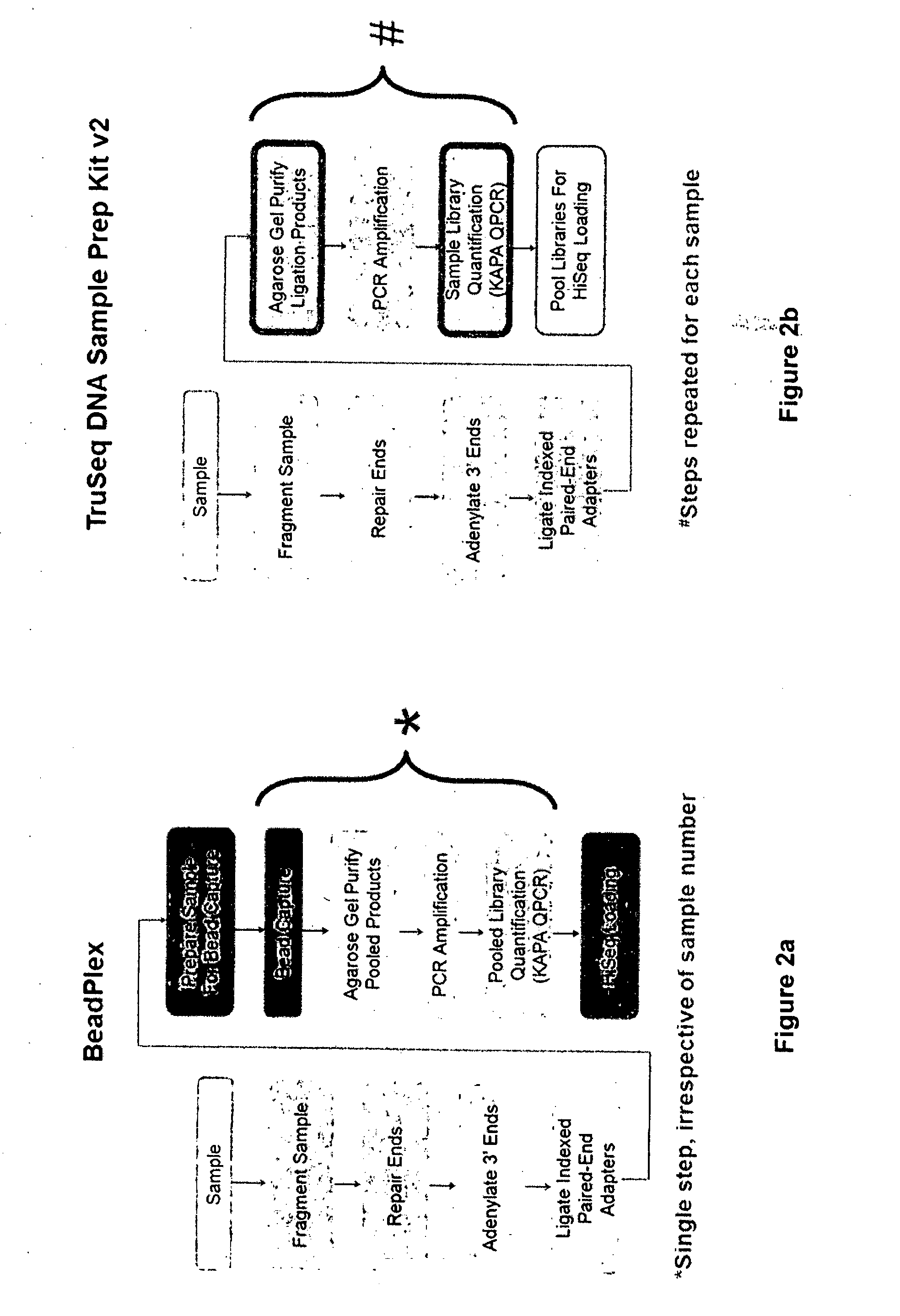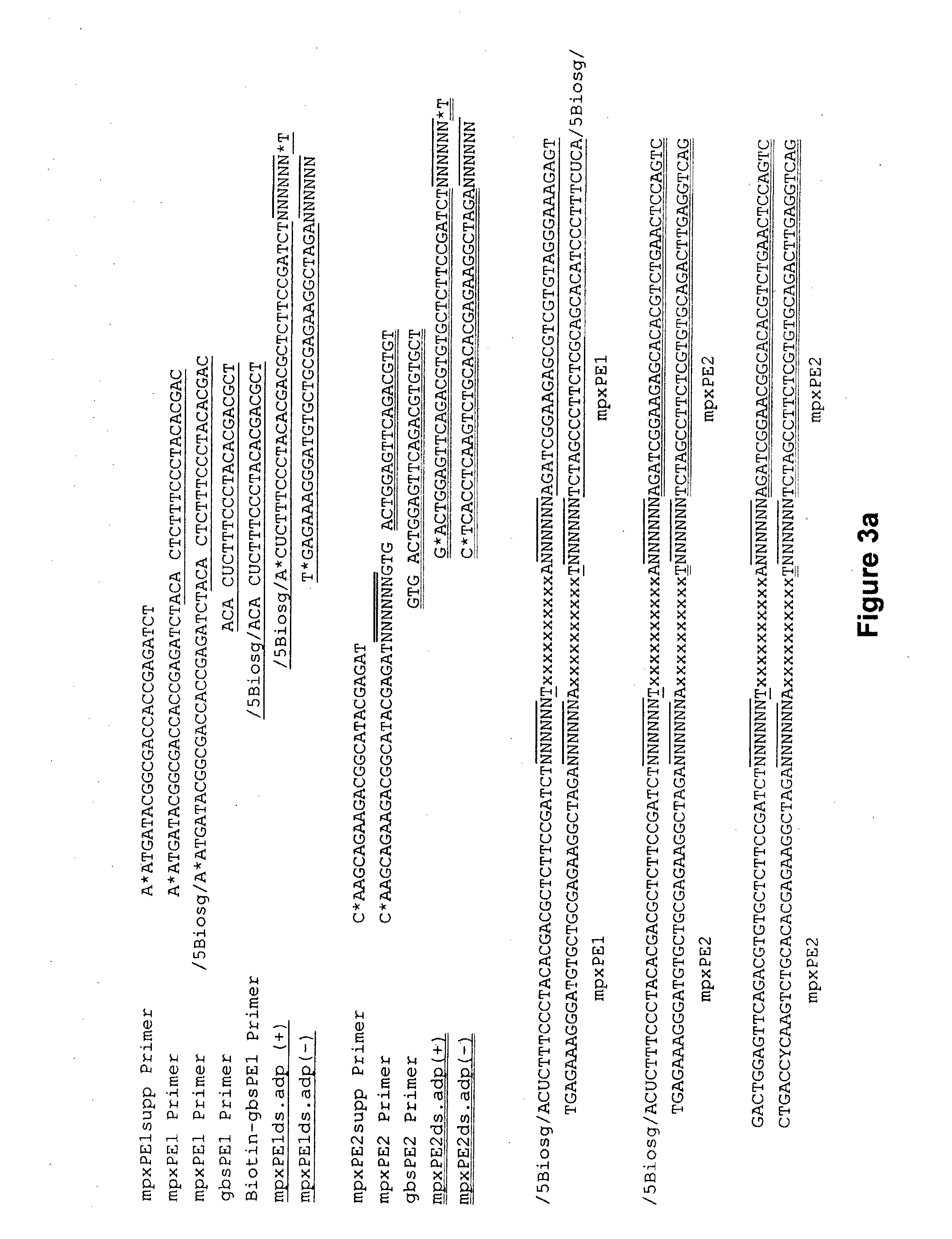Method of Producing a Normalised Nucleic Acid Library Using Solid State Capture Material
a nucleic acid library and solid state technology, applied in the field of nucleic acid preparation methods, can solve the problems of reducing the cost per nucleotide of sequencing data by several orders of magnitude, not fully addressed, and difficulty in accurately and easily partitioning sequence output across sample number and data density, so as to facilitate substantial saturation of the binding capacity of the capture material, reduce the presence of dna in the sample, and the effect of constant amount of captured dna
- Summary
- Abstract
- Description
- Claims
- Application Information
AI Technical Summary
Benefits of technology
Problems solved by technology
Method used
Image
Examples
example 1
BeadPlex Method Optimisation
[0073]A series of pilot experiments based on real-time PCR were initially performed to investigate and optimise key parameters for BeadPlex methodology.
Biotinylated DNA to Streptavidin-Coated Magnetic Bead Ratio
[0074]The ability to normalise a sample library by solid-state streptavidin capture of biotinylated DNA relies on saturation of the binding capacity of the solid-state substrate to ensure a constant amount of DNA is immobilised for each sample. To determine the fold excess of biotinylated DNA required to saturate a given amount of MyOne™ streptavidin-coated magnetic beads, we incubated 1 μg of a 125-bp biotinylated PCR product in triplicate with sufficient MyOne™ beads to theoretically bind 500, 250, 125 and 62.5 ng of biotinylated fragments. This corresponded to a 2, 4, 8 and 16-fold excess of biotinylated DNA, respectively. The choice of 1 μg biotinylated DNA input was based on the typical yield of genomic DNA from a standard Illumina TruSeq libr...
example 2
BeadPlex Method Validation
Evenness (Uniformity) of Sequence Coverage
[0084]A limitation of qPCR for optimising key parameters for BeadPlex is detection sensitivity, since each cycle of amplification theoretically represents a two-fold change in the number of DNA molecules. In contrast, next-generation sequencing enables precise quantification of the abundance of DNA molecules by virtue of sequence read counts. To determine if the BeadPlex parameters investigated in the pilot experiments using qPCR translated into robust normalisation of sample libraries when next-generation sequenced, we performed a series of experiments to assess the evenness (or uniformity) of sequence coverage across samples in BeadPlex-prepared libraries.
[0085]In the first experiment, the uniformity of sample capture to MyOne™ beads was re-examined by preparing a pool of 24 samples for next-generation sequencing. One μg of biotinylated DNA was prepared for each sample by PCR amplification of the same 300-bp fragm...
example 3
High-Throughput, Automatable Method for Highly Parallel Preparation of Samples for Next-Generation Sequencing
[0094]Enables flexible and scalable preparation of samples for sequencing, and sequence output generated for each sample to be effectively managed.
[0095]For DNA capture-based GBS, it provides sample throughput and scalability required in the project and ensures a uniform sequence output for each sample.
[0096]BeadPlex was developed to enable efficient management of sequence output across sample number and data density.
[0097]Up to 35 Gb (350 million PE reads) per HiSeq lane
[0098]Within lane sample multiplexing[0099]Pooling samples into a single lane increases number of samples analysed per run[0100]A unique identifier tag (third read index) added to each sample library enables accurate downstream sample tracking[0101]Commercial kits currently support multiplexing of up to 96 samples
[0102]FIG. 8 shows two rate limiting steps for processing large sample numbers.
[0103]BeadPlex may...
PUM
| Property | Measurement | Unit |
|---|---|---|
| relative concentrations | aaaaa | aaaaa |
| concentrations | aaaaa | aaaaa |
| nucleic acid | aaaaa | aaaaa |
Abstract
Description
Claims
Application Information
 Login to View More
Login to View More - R&D
- Intellectual Property
- Life Sciences
- Materials
- Tech Scout
- Unparalleled Data Quality
- Higher Quality Content
- 60% Fewer Hallucinations
Browse by: Latest US Patents, China's latest patents, Technical Efficacy Thesaurus, Application Domain, Technology Topic, Popular Technical Reports.
© 2025 PatSnap. All rights reserved.Legal|Privacy policy|Modern Slavery Act Transparency Statement|Sitemap|About US| Contact US: help@patsnap.com



